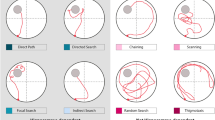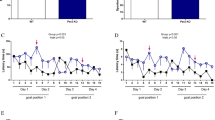Abstract
Alzheimer disease (AD) is a growing health problem globally, which causes a progressive decline in learning and memory and multiple disturbances of circadian rhythms. Six Alzheimer’s mice and six wild type (WT) mice were involved in this study. Morris Water Maze (MWM) tasks were conducted hourly to evaluate their circadian learning and memory performance. We used a single cosinor-based method to evaluate the circadian learning and memory of Alzheimer’s mice and WT mice, respectively. An area sensor was used to record locomotor activity for 2 weeks continuously, including 7 days of 12 h light/12 h dark (LD) conditions and 7 days of 12 h dark/12 h dark (DD) conditions. All WT mice showed circadian rhythm presence in learning and memory, and the peak of escape latency appeared at circadian time (CT) 12. Only one in six Alzheimer’s mice showed a circadian rhythm, but the peak of escape latency was postponed to CT20. Alzheimer’s mice showed rhythm absence under LD or DD conditions. Under LD conditions, the WT mice activity was higher than that in the Alzheimer’s mice during ZT0–5 (p = 0.007) and ZT18–23 (p = 0.353) but lower during ZT6–11 (p < 0.001) and ZT12–17 (p < 0.001). Learning and memory of wild type mice is proved to have a circadian variation throughout a day. In Alzheimer’s mice, rhythmic locomotor activity and circadian learning and memory performance were disrupted. Understanding the role of rhythmic disturbances in the process of AD may assist to identify therapeutic targets.







Similar content being viewed by others
References
Alzheimer's Association (2016) Alzheimer's disease facts and figures. Alzheimers Dement 12(4):459–509
American Psychiatric Association (2000) Diagnostic and Statistical Manual of Mental Disorders, 4th Ed., Text Revision. American Psychiatric Association, Washington, DC
Barnes DE, Yaffe K (2011) The projected effect of risk factor reduction on Alzheimer’s disease prevalence. Lancet Neurol 10(9):819–828
Boggs KN, Kakalec PA, Smith ML, Howell SN, Flinn JM (2017) Circadian wheel running behavior is altered in an APP/E4 mouse model of late onset Alzheimer’s disease. Physiol Behav 182:137–142
Brzecka A, Leszek J, Ashraf GM et al (2018) Sleep disorders associated with Alzheimer's disease: a perspective. Front Neurosci 12:330
Chaudhury D, Loh DH, Dragich JM et al (2008) Select cognitive deficits in vasoactive intestinal peptide deficient mice. BMC Neurosci 9:63
Coogan AN, Schutová B, Husung S, Furczyk K, Baune BT, Kropp P, Häßler F, Thome J (2013) The circadian system in Alzheimer’s disease: disturbances, mechanisms, and opportunities. Biol Psychiatry 74(5):333–339. https://doi.org/10.1016/j.biopsych.2012.11.021
Cornelissen G (1990) From various kinds of heart rate variability to chronocardiology. Am J Cardiol 66:863–868
Duncan MJ, Smith JT, Franklin KM, Beckett TL, Murphy MP, St Clair DK, Donohue KD, Striz M, O'Hara BF (2012) Effects of aging and genotype on circadian rhythms, sleep, and clock gene expression in APPxPS1 knock-in mice, a model for Alzheimer’s disease. Exp Neurol 236(2):249–258
Eckel-Mahan KL, Phan T, Han S, Wang H, Chan GC, Scheiner ZS, Storm DR (2008) Circadian oscillation of hippocampal MAPK activity and cAmp: implications for memory persistence. Nat Neurosci 11(9):1074–1082
Gerstner JR, Yin JC (2010) Circadian rhythms and memory formation. Nat Rev Neurosci 11(8):577–588
Ghosh S, Wu MD, Shaftel SS, Kyrkanides S, LaFerla F, Olschowka JA, O'Banion MK (2013) Sustained Interleukin-1 overexpression exacerbates tau pathology despite reduced amyloid burden in an Alzheimer’s mouse model. J Neurosci 33(11):5053–5064
Guo L, Du H, Yan S et al (2013) Cyclophilin D deficiency rescues axonal mitochondrial transport in Alzheimer's neurons. PLoS One 8(1):e54914
Halberg F (1969) Chronobiology. Annu Rev Physiol 31:675–725
Hampp G, Ripperger JA, Houben T, Schmutz I, Blex C, Perreau-Lenz S, Brunk I, Spanagel R, Ahnert-Hilger G, Meijer JH, Albrecht U (2008) Regulation of monoamine oxidase a by circadian-clock components implies clock influence on mood. Curr Biol 18(9):678–683
Harper DG, Stopa EG, McKee AC et al (2004) Dementia severity and lewy bodies affect circadian rhythms in Alzheimer disease. Neurobiol Aging 25(6):771–781
Jilg A, Lesny S, Peruzki N, Schwegler H, Selbach O, Dehghani F, Stehle JH (2010) Temporal dynamics of mouse hippocampal clock gene expression support memory processing. Hippocampus 20:377–388
Kerren C, Linde-Domingo J, Hanslmayr S et al (2018) An optimal oscillatory phase for pattern reactivation during memory retrieval. Curr Biol 28:3383–3392
Konsman JP (2003) The mouse brain in stereotaxic coordinates. Psychoneuroendocrino 28(6):827–828
Lamont EW, Robinson B, Stewart J, Amir S (2005) The central and basolateral nuclei of the amygdala exhibit opposite diurnal rhythms of expression of the clock protein Period2. Proc Natl Acad Sci U S A 102:4180–4184
Leifer BP (2003) Early diagnosis of Alzheimer’s disease: clinical and economic benefits. J Am Geriatr Soc 51:S281–S288
Lim MM, Gerstner JR, Holtzman DM (2014) The sleep-wake cycle and Alzheimer's disease: what do we know? Neurodegener Dis Manag 5:351–362
Musiek ES, Holtzman DM (2016) Mechanisms linking circadian clocks, sleep, and neurodegeneration. Science 354(6315):1004–1008. https://doi.org/10.1126/science.aah4968
Prince M, Bryce R, Albanese E et al (2013) The global prevalence of dementia: a systematic review and meta-analysis. Alzheimers Dement 9:63–75
Reitz C, Mayeux R (2014) Alzheimer disease: epidemiology, diagnostic criteria, risk factors and biomarkers. Biochem Pharmacol 88(4):640–651
Reppert SM, Weaver DR (2002) Coordination of circadian timing in mammals. Nature. 418:935–941
Rose KM, Beck C, Tsai PF, Liem PH, Davila DG, Kleban M, Gooneratne NS, Kalra G, Richards KC (2011) Sleep disturbances and nocturnal agitation behaviors in older adults with dementia. Sleep. 34(6):779–786
Sarazin M, Berr C, De Rotrou J et al (2007) Amnestic syndrome of the medial temporal type identifies prodromal AD: a longitudinal study. Neurology 69(19):1859–1867
Schenck CH, Boeve BF, Mahowald MW (2013) Delayed emergence of a parkinsonian disorder or dementia in 81% of older men initially diagnosed with idiopathic rapid eye movement sleep behavior disorder: a 16-year update on a previously reported series. Sleep Med Aug 14(8):744–748
Schmidt C, Collette F, Cajochen C et al (2007) A time to think: circadian rhythms in human cognition. Cogn Neuropsychol 27:755–789
Schnöder L, Hao W, Qin Y et al (2015) Deficiency of neuronal p38α MAPK attenuates amyloid pathology in Alzheimer disease mouse and cell models through facilitating Lysosomal degradation of BACE1. J Biol Chem 291(5):2067–2079
Sterniczuk R, Theou O, Rusak B, Rockwood K (2013) Sleep disturbance is associated with incident dementia and mortality. Curr Alzheimer Res 10(7):767–775
Tractenberg RE, Singer CM, Kaye JA (2005) Symptoms of sleep disturbance in persons with Alzheimer's disease and normal elderly. J Sleep Res 14(2):177–185
Videnovic A, Lazar AS, Barker RA, Overeem S (2014) 'The clocks that time us'--circadian rhythms in neurodegenerative disorders. Nat Rev Neurol 10(12):683–693. https://doi.org/10.1038/nrneurol.2014.206
Wang LMC, Dragich JM, Kudo T et al (2009) Expression of the circadian clock gene Period2 in the Hippocampus: possible implications for synaptic plasticity and learned behaviour. ASN Neuro 1(3):e00012. https://doi.org/10.1042/AN20090020
Weiner MW, Veitch DP, Aisen PS, Beckett LA, Cairns NJ, Green RC, Harvey D, Jack CR, Jagust W, Liu E, Morris JC, Petersen RC, Saykin AJ, Schmidt ME, Shaw L, Siuciak JA, Soares H, Toga AW, Trojanowski JQ, Alzheimer’s Disease Neuroimaging Initiative (2011) The Alzheimer's disease neuroimaging initiative: a review of papers published since its inception. Alzheimers Dement 8(1 Suppl):S1–S68
Woods B, Aguirre E, Spector AE et al (2012) Cognitive stimulation to improve cognitive functioning in people with dementia. Cochrane Database Syst Rev (2. Art. No.: CD005562). https://doi.org/10.1002/14651858.CD005562.pub2
Yu L, Wang S, Chen X, Yang H, Li X, Xu Y, Zhu X (2015) Orientin alleviates cognitive deficits and oxidative stress in Aβ1–42-induced mouse model of Alzheimer’s disease. Life Sci 121:104–109
Zhu X, Chen C, Ye D et al (2012) Diammonium glycyrrhizinate upregulates PGC-1alpha and protects against Abeta1–42-induced neurotoxicity, PLoS One. 7 e35823.
Funding
This study was funded by the National Nature Science Foundation of China (31371180) and the Key Technology Research and Development Program of Science and Technology of Sichuan Province (2015SZ0193).
Author information
Authors and Affiliations
Contributions
Xuepei Li, study concept and design, animal experiments, analysis and interpretation of data,
Junwen Guan, design and interpretation data.
Tong Sun, animal experiments.
Jingguo Yang, animal experiments.
Hangyu, statistical analysis.
Junjie Yao, circadian rhythm calculation.
Zhengrong Wang, study supervision.
Corresponding author
Ethics declarations
Ethics statement
This study was carried out in accordance with the recommendations of “Research Ethics Committee of College of Basic Medicine and Forensic Medicine, Sichuan University”. The protocol was approved by “College of Basic Medicine and Forensic Medicine, Sichuan University”.
Conflict of interest
No potential conflicts of interest were reported by the authors.
Statement confirming
This study did not require a registration.
Additional information
Publisher’s note
Springer Nature remains neutral with regard to jurisdictional claims in published maps and institutional affiliations.
Rights and permissions
About this article
Cite this article
Li, X., Guan, J., Sun, T. et al. Circadian learning and memory changes in Aβ1–42 induced Alzheimer’s mice. Metab Brain Dis 35, 463–471 (2020). https://doi.org/10.1007/s11011-019-00509-x
Received:
Accepted:
Published:
Issue Date:
DOI: https://doi.org/10.1007/s11011-019-00509-x




